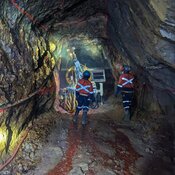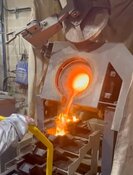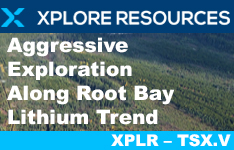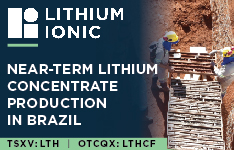I was in a restaurant the other day relaxing in the company of five sexagenarians when I overheard a group of Millennials discussing their current financial condition, and while the cost of living and job security seemed to be a common concern, the item of utmost concern was their mortgages. They complained about the cost of dining out, and they whined about the fees banks charge, but when it came to the topic of saving and investing, not one word was mentioned about mining.
I heard lots of banter about artificial intelligence and the name "Nvidia" mentioned a few dozen times, but one thing that stood out like a sore thumb was that they were all texting or talking or surfing on their iPhones. Every participant at the table had an iPhone and barely put it down, except maybe to take a bite of their dinner.
As I was watching and listening to this bizarre event, there was a moment where the stark reality of the last 20 years of unbridled credit creation and money growth suddenly took on new meaning. These "kiddies" are throwing around comparisons of monthly payments on CA$500,000 to $1,000,000 mortgages, as I would talk about a $2,000 credit line. I was aghast at the flippancy with which they laughed about renewing mortgages on "Starter Homes" that cost them $1.4 million with postage stamp backyards and 1,500 square feet of living space.
The housing situation in Canada is in full crisis mode as the population of the big cities has exploded, forcing these new arrivals to the housing market to pay exorbitant rents and prices just to find a place to live. Thanks largely to the immigration policies of the Liberal-NDP coalition, there was no planning whatsoever related to accommodating wave after wave of immigrants, creating a cost-push inflationary spiral of higher rents, forcing higher prices, and repeating itself despite the attempts of the Bank of Canada to curtail demand by raising interest rates.
Back in the 1980s, the Baby Boom Generation moved into the workforce after college or high school while renting an apartment and saving and investing until they had enough money to make a down payment large enough to qualify for a mortgage. I was in the investment business, and the one glaring difference between then and now is that everyone who had a job had a savings account with enough money to "dabble" in stocks. They "dabbled" because they all wanted to accelerate the growth of their savings so they could buy a house, and even after they bought a house, there was always enough money around to "dabble."
The Boomer demographic was large enough back in the 80s, such that the TSX Venture Exchange (then called "The Vancouver Stock Exchange") became the avenue of choice for "informed speculation" long before the advent of smartphones and internet brokerage accounts and social media. Speculators learned about "hot deals" over the phone because it wasn't until the late 1980s, while touring downtown Vancouver, that I got my first glimpse of a stock promoter pitching his wares on an old Motorola phone.
This was long before legalized gambling and lotteries surely became a distraction for the hardcore mining stock enthusiast. It was before cryptocurrencies and our government-sanctioned "weed" industry that launched a whole new breeding ground for non-mining speculation. In other words, the avenue of choice for growing one's wealth quickly spread out and away from the mineral exploration fields like oil and gas and mining and into areas far more familiar to this new generation of investors that would rather smoke weed and talk on their iPhones than hear about diamonds in the Arctic.
Every time I hear a discussion about stocks (or investing in general) between this new generation of speculators, I wonder to myself if they have any clue how many different metals are involved in the manufacturing of the iPhone they are using to place an order to buy shares in the company that manufactures it (AAPL)?
46 different elements are required to build that wonderful contraption that they absolutely cannot be without for more than a washroom break without having withdrawals.
"Gold is a barbarous relic" with a utility function, not a lot different than a "pet rock," the gold bears say. Yet there it is — front and center — as an integral component of the iPhone. Has any of the "kiddies" taken the time to learn the origin of gold deposits or how they are found and mined? I suspect not. The same applies to the other 45 elements involved in the process and, if by some unfortunate chance, the world ran out of copper, eliminating substitution as a solution, the cost of an iPhone would most certainly skyrocket as raw material prices are critical to pricing.
Since October of 2022, gold prices have been the unyielding focus of an entirely new group of buyers, few if any, that speak the English language as their native tongue. Based purely on the reports of bullion movements from New York to London and abroad, there continues to this day to be a perpetual flow of "barbarous relics" from the West to the East as thousands of years of societal traditions emblazon its role as a "protector of wealth."
This is a passing of the torch of sorts, as citizens in the East are slowly moving from the working and lower classes into the middle and upper-middle classes, and with that, they are maintaining their historical reverence for gold as a symbol of prosperity and safety. The West, by contrast, is consumed by a blind devotion to "paper" — certificates issued as promises with nothing except "forward guidance" as surety.
The West has been creating more and more paper products in every cycle of credit creation called "quantitative counterfeiting," in which the purchasing power of savings created from the labor of citizens continues to erode.
If you look around the world at the various continents and examine the number of alliances made by the East with those governments, you notice that there continues to be a systematic effort to control all of those elements required in an iPhone.
China's Global Alliances
One glance at the map illustrating China's global alliances depicts a country on a mission. Now, one could argue that the United States has an even greater network of allies by way of the universal acceptance of the U.S. dollar as the world's reserve currency. However, I would consider the issuance of one's domestic currency around the world to be anything but "strategic."
I offer as a contrast the Kamoa-Kakula Copper Complex in the Democratic Republic of Congo, where Bob Friedland's Ivanhoe Mines is a 39.6% owner along with Zijin Mining at 39.6%, Crystal River Global at 8% and the DRC Government at 20%. (Zijin's largest shareholder is Shanghang Minxi Xinghang State-Owned Property Investment Company, which holds 24% of Zijin, is owned by the government of Shanghang County, Fujian Province, where Zijin's head office is located.)
This represents a functional alliance between China and the DRC that offers jobs and growth as opposed to the simple use of "paper" (U.S. dollars). China has a presence everywhere except certain parts of Africa and the U.S. as part of a long-term global initiative to secure the supply chain for any and all commodities, both hard and soft. With strategic planning such as this, one must ask why they are gathering every ounce of available gold bullion and shipping it home, never to be seen again. The new generation of portfolio managers is in need of a history lesson, the likes of which gold is about to teach.

The price of bullion had a superb week, and notwithstanding that I completely missed this last move off the lows around $2,300, it certainly looks as though it is going to punch out through $2,477 (an all-time high for August Gold) within short order. What remains a baffling conundrum for many of us who sport a few grey hairs in our beards is the disconnect between gold prices and valuation for the gold miners, particularly the junior developers. Starting with VanEck Gold Miners ETF (GDX:NYSEARCA), you can see that it is making a fourth attempt to break above the 2020 top around $44, and while that is fine and good, it must be remembered that in 2011, it hit $60 the first time bullion tested $2,000 per ounce.
In fact, since that top in gold, the GDX-to-gold ratio has dropped 72.3% This ratio (now at .158) just broke above a downtrend line drawn off the 2022 and 2023 peaks and looks ready to test the next downtrend line from 2020 and 2022 peaks. I now think that the Senior Gold Miners have a better-than-average chance of outperforming gold bullion for the first time in over a decade.
Now, IF this turns out to be a reality, then I am finally forced to revisit VanEck Junior Gold Miner ETF (GDXJ:NYSEArca), which has been grinding along step-for-step with the Senior Gold Miners ETF, which is not necessarily a bullish attribute. Year-to-date, both the senior and junior miners are moving in an eery tandem, with GDXJ up 25.53% and GDX right behind, up 23.09%.
In past bull markets, long before the advent of the ETFs, junior gold producers always outperformed the seniors by a wide margin. However, providing even greater upside leverage were the junior gold developers, not yet in commercial production but in possession of sizable gold resources that inevitably caught the attention of the intermediate and senior producers.
This is where, in the 2001-2011 period, many of the intermediates got into trouble because the investment bankers convinced them that adding ounces at any cost would be accretive to valuation and, eventually, earnings. Accordingly, companies like Trelawney Mining and Resources took an old, heavily worked project called the Cote Mine south of Timmins, Ontario, paid a chap to provide a revised resource estimate, which came in north of five million ounces, and then pitched it to IAMGOLD Corp. (IMG:TSX; IAG:NYSE), which promptly forked over CA$608 million for the company.
Several months later, IAM put Cote on "care-and-maintenance" when it turned out that the 35m/t of .82 g/t Au was all contained in low-grade, stacked echelon veins with the waste-to-ore ratio rendering it sub-economic. IAMGOLD was not the only one that erred in its aspirations for the "total ounces" crown. Barrick Gold blew their brains out on the Argentina-Chile border with several billion spent on Pascua-Lama and was just fined $16m by the Chilean government for violations of environmental rules.
The net result of the dismal operating performance of the seniors and intermediate producers in that era ushered in a new mindset that was far less aggressive in acquisitions and far more attentive to balance sheets and income statements. Companies like Barrick Gold Corp. (ABX:TSX; GOLD:NYSE) and Newmont Corp. (NEM:NYSE) began diversifying away from "gold-only" deposits while avoiding the junior acquisition path for fear of accelerating shareholder unrest, leading to acute career risk.
The large sufferers in this rebirth of the major miners since 2011 have been the junior developers. Companies with "indicated and inferred" resources that are not quite beyond the threshold deemed "marketable" by the M&A crowd are told to "Come back when you have a Tier One Asset." Now, the whole idea of "Tier One" was formulated after 2011 and was offered as the litmus test for the majors to avoid disastrous outcomes every time they pulled out their checkbooks. With gold bouncing around the $1,250/oz. level, the investment bankers were telling everyone that they needed more "indicated and measured" rather than "indicated and inferred" and have been carrying this mantra of "5m ounces or don't waste my time!" since 2011, all the while watching gold prices move up, up, and away to the point where gold is one rate cut away from the $2,500/oz. level.
Now, I am not a financial genius by any stretch, but if these banking/engineering wizards needed 5m ounces at $1,250 gold, what, pray tell, might they need at $2,500 gold? Of course, I should be factoring in increased mining costs, but it surely stands to reason that what was a "marginal" resource at $1,250 gold surely must be seriously upgraded to $2,500 gold. Basic Math-101 suggests that there is a slew of junior developers wandering around aimlessly in the financial wilderness, bereft of sponsorship (and equally bereft of money) despite having gold deposits that might have brought in $500 million twenty years ago when gold was less than half the price! For the reasons mentioned above, I think that the hidden gems in today's market are the junior gold developers.
As many of my followers know, I am a bull on copper and continue to rate it as the #1 metal to own in 2024 and beyond. In prior missives, I have painted the case for $6-8/lb. Cu prices by the turn of the decade, so when you combine the copper narrative with the gold narrative, one has to focus on companies with decently-sized gold resources trading south of the $25/ounce valuation level in secure jurisdictions and proven management teams. If one is looking to go to exploration companies, those in the hunt for copper-gold porphyry or IOCG deposits will have the biggest market reactions to discoveries or drill programs that significantly enhance the size and confidence in their resource.
My largest junior developer holding remains Getchell Gold Corp. (GTCH:CSE; GGLDF:OTCQB), whose 2,059,900 ounces in Nevada (and wide open to depth and along strike) fits the bill perfectly as a resource certain to be rerated in 2024. I am certain that an intermediate miner could use a project with that many ounces with that much blue-sky potential once the drills are back turning.
My second largest junior holding is Fitzroy Minerals Inc. (FTZ:TSX.V; FTZFF:OTCQB), whose recent announcement of an exclusivity agreement with Ptolemy Mining gives them a portfolio of one grass-roots exploration play in Argentina (headed by the discoverer of Pan American Silver Corp.'s (PAAS:TSX; PAAS:NASDAQ) Navidad silver deposit), two grassroots copper plays in Chile, and an advanced exploration IOCG (iron-oxide-copper-gold) project in Chile, located 40 km southwest of the monstrous Candelaria Mine, owned and operated by the Lundin Mining Group. (Subscribers have a list of several other high-profile junior copper-gold developers for their review.)
Stocks
Like a great many of my colleagues and associates who can tell you where they were when the Challenger blew up, the current market environment is about as bazaar as we have ever witnessed. Traditional securities analysis has been thrown out of the proverbial window, with the Dow breaching 40,000 and a new ATH. The S&P 500 also hit a new ATH, while the NASDAQ got there on Thursday before backing off.
Market leadership is slowly rolling over, with four of the MAG Seven lower on Friday and sentiment leader Nvidia Corp. (NVDA:NASDAQ) still $11 of its ATH last seen on June 20. My old saw that continues to haunt me every single time I experience these runaway market blow-offs (in which I am either "out" or "lightly short") is this phrase:
"Never underestimate the replacement power of equities within an inflationary spiral."
While the Fed has been waving a pink handkerchief in the air pretending to be in full tightening mode, over at the U.S. Treasury, Janet Yellen has been pumping trillion in stimulus money into the U.S. economy while ensuring that the headline numbers (that attract votes) like jobs, CPI, GDP are all sufficiently doctored to reflect strong leadership and vibrant economic performance. What they fail to trumpet are the downward revisions to every single number, but what is important is that the liquidity being injected into the system is soon going to stop abruptly by way of a new Administration or by a rebellious bond market. One way or another, the "inflationary spiral," which, by the way, is not the consumer prices index, is about to reverse, so "the replacement value of equities" is about to run into a valuation windshield.
It is one thing to be wrong on a trade, but it is entirely maddening the way regulators have been granting Tesla Inc. (TSLA:NASDAQ) pass after pass after pass throughout this long travesty of broken securities rules as the stock gets whomped on Thursday and then is allowed to trot out their resident shill to tell everyone that the delay in the robo-taxi launch was "a non-event."
It does not matter that Elon the Magnificent tweeted out that the roll-out date was "8/8/2024" and then missed it. It does not matter that a few years back, he announced to the world that he had backing to take the company private, which also proved false. I am certain that readers of this missive will think I am in the grips of a severe case of OCD in my morbid infatuation with an EV manufacturer that just laid off 10% of its global workforce and, at last glance, was under investigation by the DoJ.
The bee buzzing around in my bonnet is that the Tesla Cult is all about wanting to believe that Elon will deliver them into the Promised Land of market share dominance and market cap superiority in a glutted EV environment but in the face of deteriorating fundamentals and outright overvaluation. I know all the "woke" readers will think it is sacrilege for me to look upon this "green movement innovator" with such disdain, but enough is summary, ENOUGH. I am looking for a sub-$100 price by the end of 2024.
| Want to be the first to know about interesting Gold and Technology investment ideas? Sign up to receive the FREE Streetwise Reports' newsletter. | Subscribe |
Important Disclosures:
- As of the date of this article, officers and/or employees of Streetwise Reports LLC (including members of their household) own securities of Getchell Gold Corp., Fitzroy Minerals Inc., Pan American Silver Corp., and Barrick Gold Corp.
- Michael Ballanger: I, or members of my immediate household or family, own securities of: Fitzroy Minerals Inc. and Getchell Gold Corp. My company has a financial relationship with Fitzroy Minerals Inc. I determined which companies would be included in this article based on my research and understanding of the sector.
- Statements and opinions expressed are the opinions of the author and not of Streetwise Reports, Street Smart, or their officers. The author is wholly responsible for the accuracy of the statements. Streetwise Reports was not paid by the author to publish or syndicate this article. Streetwise Reports requires contributing authors to disclose any shareholdings in, or economic relationships with, companies that they write about. Any disclosures from the author can be found below. Streetwise Reports relies upon the authors to accurately provide this information and Streetwise Reports has no means of verifying its accuracy.
- This article does not constitute investment advice and is not a solicitation for any investment. Streetwise Reports does not render general or specific investment advice and the information on Streetwise Reports should not be considered a recommendation to buy or sell any security. Each reader is encouraged to consult with his or her personal financial adviser and perform their own comprehensive investment research. By opening this page, each reader accepts and agrees to Streetwise Reports' terms of use and full legal disclaimer. Streetwise Reports does not endorse or recommend the business, products, services or securities of any company.
For additional disclosures, please click here.
Michael Ballanger Disclosures
This letter makes no guarantee or warranty on the accuracy or completeness of the data provided. Nothing contained herein is intended or shall be deemed to be investment advice, implied or otherwise. This letter represents my views and replicates trades that I am making but nothing more than that. Always consult your registered advisor to assist you with your investments. I accept no liability for any loss arising from the use of the data contained on this letter. Options and junior mining stocks contain a high level of risk that may result in the loss of part or all invested capital and therefore are suitable for experienced and professional investors and traders only. One should be familiar with the risks involved in junior mining and options trading and we recommend consulting a financial adviser if you feel you do not understand the risks involved.




































